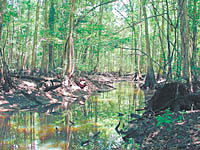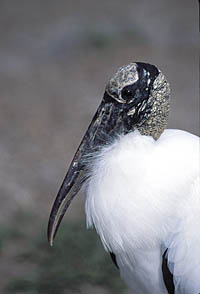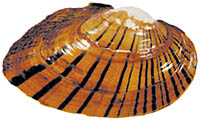Georiga Water Science Center
U.S. Geological Survey General Interest Publication 4
 The swamps and wetlands of southwestern Georgia provide unique plant and animal habi-tats. The Swamp of Toa—also referred to as the Chickasawhatchee Swamp—is one of the largest remaining, relatively intact, fresh-water swamps in the Southeastern United States. The swamp is a critical site for migratory birds, freshwater fish and mus-sels, and animal and plant communities.
The swamps and wetlands of southwestern Georgia provide unique plant and animal habi-tats. The Swamp of Toa—also referred to as the Chickasawhatchee Swamp—is one of the largest remaining, relatively intact, fresh-water swamps in the Southeastern United States. The swamp is a critical site for migratory birds, freshwater fish and mus-sels, and animal and plant communities.  Many of these plant and animal species—such as the bald eagle, wood stork, mussels (shinyrayed pocketbook, oval pigtoe, gulf moccasinshell), swamp buckthorn, and variable-leaved Indian plantain—are listed as feder-ally or State threatened or endan-gered. “The Chickasawhatchee Swamp purchase is our largest single land purchase in recent history,” said David Waller, Director of the Wildlife Resource Division of the Georgia Department of Natural Resources (GaDNR) “… and will allow us to preserve an environmentally signif-icant piece of property for future generations as well as provide many opportunities for outdoor education and recreational activities such as hunting, shing, bird watching, hiking and canoeing” (accessed April 21, 2003, at http://nature.org/ wherewework/northamerica/states/ georgia/press/press438.html).
Many of these plant and animal species—such as the bald eagle, wood stork, mussels (shinyrayed pocketbook, oval pigtoe, gulf moccasinshell), swamp buckthorn, and variable-leaved Indian plantain—are listed as feder-ally or State threatened or endan-gered. “The Chickasawhatchee Swamp purchase is our largest single land purchase in recent history,” said David Waller, Director of the Wildlife Resource Division of the Georgia Department of Natural Resources (GaDNR) “… and will allow us to preserve an environmentally signif-icant piece of property for future generations as well as provide many opportunities for outdoor education and recreational activities such as hunting, shing, bird watching, hiking and canoeing” (accessed April 21, 2003, at http://nature.org/ wherewework/northamerica/states/ georgia/press/press438.html).
 A portion of the area was recently designated as the Swamp of Toa Important Bird Area (IBA). The aim of the National IBA program is to identify and conserve key breeding and feeding sites for birds. IBAs are considered by the North American Bird Conservation Initiative to be excep-tionally important for bird conservation (accessed April 21, 2003, at http://www.audubon.org/bird/iba).
A portion of the area was recently designated as the Swamp of Toa Important Bird Area (IBA). The aim of the National IBA program is to identify and conserve key breeding and feeding sites for birds. IBAs are considered by the North American Bird Conservation Initiative to be excep-tionally important for bird conservation (accessed April 21, 2003, at http://www.audubon.org/bird/iba).
Recent USGS publications on Georgia or Georgia Water-Resources Information
For more information, please contact webmaster-ga@usgs.gov.